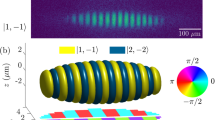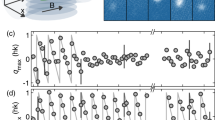Abstract
Attraction between the atoms of a Bose–Einstein condensate renders it unstable to collapse, although a condensate with a limited number of atoms1 can be stabilized2 by confinement in an atom trap. However, beyond this number the condensate collapses3,4,5. Condensates constrained to one-dimensional motion with attractive interactions are predicted to form stable solitons, in which the attractive forces exactly compensate for wave-packet dispersion1. Here we report the formation of bright solitons of 7Li atoms in a quasi-one-dimensional optical trap, by magnetically tuning the interactions in a stable Bose–Einstein condensate from repulsive to attractive. The solitons are set in motion by offsetting the optical potential, and are observed to propagate in the potential for many oscillatory cycles without spreading. We observe a soliton train, containing many solitons; repulsive interactions between neighbouring solitons are inferred from their motion.




Similar content being viewed by others
References
Ruprecht, P. A., Holland, M. J., Burnett, K. & Edwards, M. Time-dependent solution of the nonlinear Schrodinger equation for Bose-condensed trapped neutral atoms. Phys. Rev. A 51, 4704–4711 (1995)
Bradley, C. C., Sackett, C. A. & Hulet, R. G. Bose-Einstein condensation of lithium: observation of limited condensate number. Phys. Rev. Lett. 78, 985–989 (1997)
Sackett, C. A., Gerton, J. M., Welling, M. & Hulet, R. G. Measurements of collective collapse in a Bose-Einstein condensate with attractive interactions. Phys. Rev. Lett. 82, 876–879 (1999)
Gerton, J. M., Strekalov, D., Prodan, I. & Hulet, R. G. Direct observation of growth and collapse of a Bose–Einstein condensate with attractive interactions. Nature 408, 692–695 (2000)
Donley, E. A. et al. Dynamics of collapsing and exploding Bose–Einstein condensates. Nature 412, 295–299 (2001)
Stegeman, G. I. & Segev, M. Optical spatial solitons and their interactions: Universality and diversity. Science 286, 1518–1523 (1999)
Dalfovo, F., Giorgini, S., Pitaevskii, L. P. & Stringari, S. Theory of Bose-Einstein condensation in trapped gases. Rev. Mod. Phys. 71, 463–512 (1999)
Burger, S., Bongs, K., Dettmer, S., Ertmer, W. & Sengstock, K. Dark solitons in Bose-Einstein condensates. Phys. Rev. Lett. 83, 5198–5201 (1999)
Denschlag, J. et al. Generating solitons by phase engineering of a Bose-Einstein condensate. Science 287, 97–100 (2000)
Anderson, B. P. et al. Watching dark solitons decay into vortex rings in a Bose-Einstein condensate. Phys. Rev. Lett. 86, 2926–2929 (2001)
Pérez-García, V., Michinel, H. & Herrero, H. Bose-Einstein solitons in highly asymmetric traps. Phys. Rev. A 57, 3837–3842 (1998)
Muryshev, A. E., van Linden van den Heuvell, H. B. & Shlyapnikov, G. V. Stability of standing matter waves in a trap. Phys. Rev. A 60, R2665–R2668 (1999)
Carr, L. D., Leung, M. A. & Reinhardt, W. P. Dynamics of the Bose-Einstein condensate: quasi-one-dimension and beyond. J. Phys. B 33, 3983–4001 (2000)
Kivshar, Y. S., Alexander, T. J. & Turitsyn, S. K. Nonlinear modes of a macroscopic quantum oscillator. Phys. Lett. A 278, 225–230 (2001)
Schreck, F. et al. Quasipure Bose-Einstein condensate immersed in a Fermi sea. Phys. Rev. Lett. 87, 080403-1–080403-4 (2001)
Görlitz, A. et al. Realization of Bose-Einstein condensates in lower dimensions. Phys. Rev. Lett. 87, 130402-1–130402-4 (2001)
Truscott, A. G., Strecker, K. E., McAlexander, W. I., Partridge, G. B. & Hulet, R. G. Observation of Fermi pressure in a gas of trapped atoms. Science 291, 2570–2572 (2001)
McAlexander, W. I. Collisional Interactions in an Ultracold Lithium Gas. Thesis, Rice Univ. (2000)
Tiesinga, E., Verhaar, B. J. & Stoof, H. T. C. Threshold and resonance phenomena in ultracold ground-state collisions. Phys. Rev. A 47, 4114–4122 (1993)
Inouye, S. et al. Observation of Feshbach resonances in a Bose–Einstein condensate. Nature 392, 151–154 (1998)
Roberts, J. L., Claussen, N. R., Cornish, S. L. & Wieman, C. E. Magnetic field dependence of ultracold collisions near a Feshbach resonance. Phys. Rev. Lett. 85, 728–731 (2000)
Zakharov, V. E. & Shabat, A. B. Exact theory of two-dimensional self-focusing and one-dimensional self-modulation of waves in nonlinear media. Sov. Phys. JETP 34, 62–65 (1972)
Carr, L. D., Clark, C. W. & Reinhardt, W. P. Stationary solutions of the one-dimensional nonlinear Schrödinger equation. II. Case of attractive nonlinearity. Phys. Rev. A 62, 063611-1–063611-10 (2000)
Tai, K., Hasegawa, A. & Tomita, A. Observation of modulational instability in optical fibers. Phys. Rev. Lett. 56, 135–138 (1986)
Gordon, J. P. Interaction forces among solitons in optical fibers. Opt. Lett. 8, 596–598 (1983)
Hasegawa, A. Optical Solitons in Fibers (Springer, New York, 1990)
Lenz, G., Meystre, P. & Wright, E. M. Nonlinear atom optics. Phys. Rev. Lett. 71, 3271–3274 (1993)
Kasevich, M. A. Atom interferometry with Bose-Einstein condensed atoms. C.R. Acad. Sci. IV 2, 497–507 (2001)
Acknowledgements
We thank W. I. McAlexander for providing the coupled channels calculation, B. Luey for making the magnetic coils, and T. Killian and H. Stoof for discussions. This work was supported by the US National Science Foundation, NASA, the Office of Naval Research and the Welch Foundation.
Author information
Authors and Affiliations
Corresponding author
Ethics declarations
Competing interests
The authors declare that they have no competing financial interests
Rights and permissions
About this article
Cite this article
Strecker, K., Partridge, G., Truscott, A. et al. Formation and propagation of matter-wave soliton trains. Nature 417, 150–153 (2002). https://doi.org/10.1038/nature747
Received:
Accepted:
Published:
Issue Date:
DOI: https://doi.org/10.1038/nature747
- Springer Nature Limited
This article is cited by
-
Optical soliton resonances, soliton molecules to breathers for a defocusing Lakshmanan–Porsezian–Daniel system
Optical and Quantum Electronics (2024)
-
Probe for bound states of SU(3) fermions and colour deconfinement
Communications Physics (2023)
-
Overcrowding induces fast colloidal solitons in a slowly rotating potential landscape
Nature Communications (2023)
-
Spontaneous symmetry breaking induced by interaction in linearly coupled binary Bose–Einstein condensates
Nonlinear Dynamics (2023)
-
Integrability and exact solutions for a nonlocal matrix nonlinear Schrödinger equation with self-induced \(\mathcal{P}\mathcal{T}\)-symmetric potentials
Nonlinear Dynamics (2023)





